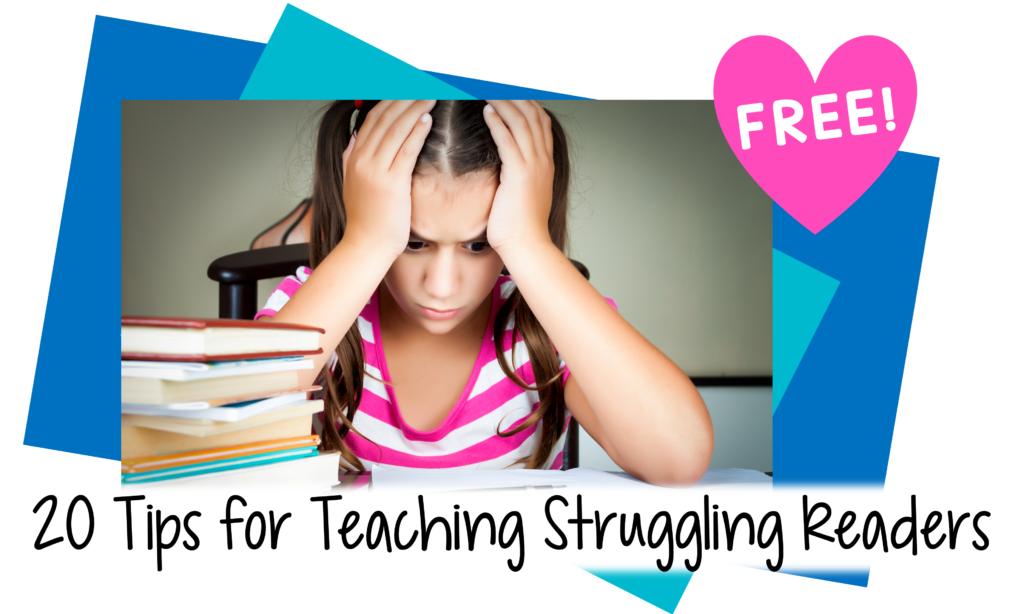Do yo u know a reluctant reader? If so, whether you are a parent or a teacher, I hope you will find some suggestions below to help.
u know a reluctant reader? If so, whether you are a parent or a teacher, I hope you will find some suggestions below to help.
As a reading specialist and classroom teacher, I’ve had the opportunity of working with many reluctant readers, and they have taught me a lot! Reluctant comes from a Latin word meaning “to struggle against.” These children struggle against reading because reading is a struggle for them. In order to teach these students, I had to come up with a variety of solutions (okay, tricks) to get them to read.
It’s helpful, though not crucial, to get some idea of why the child is averse to reading.
- Was she teased for her reading attempts?
- Have the books been too hard for him?
- Maybe she is not developmentally ready to read. Some children mature slower than others, and that means neurologically, too.
- He could be discouraged by watching his classmates do what he knows he can’t do.
- Maybe her neurological make-up isn’t compatible with the teaching method used by you or the teacher, making learning to read unnecessarily challenging.
- He could have a low frustration tolerance, or a dislike of doing anything new or difficult.
Probably a combination of factors are involved. Whatever the reasons for the child’s reluctance—and you may never know them for sure—you have lots of opportunities to encourage (okay, lure) the reluctant reader into reading.
Here’s a quick list of suggestions, followed by a more detailed discussion of each:
- Drop the reading level.
- Create books yourself.

- Do repeated readings.
- Teach fluency.
- Utilize the child’s reading strengths.
- Cautiously capitalize on the child’s interests.
- Make reading a special treat.
- Make reading fun!!
- Encourage the growth mindset.
- If all else fails, consider incentives.
Now for more detail:
1. Drop the reading level. Build up the child’s confidence before slowly nudging her along to more challenging books.
Beware of the books in stores and libraries that are labeled Easy or Level 1. Most of these books are on a 3rd to 5th grade reading level—definitely not books for emergent readers. By far the best trade books for beginners are from the HarperCollins series, I Can Read or My First I Can Read Books. You want books with lots of early high frequency words, some words that are decodable by the child, simple sentence structure, and strong picture support.
You may also want to look for “leveled readers” in the educational marketplace. Contact me if you want some suggestions.
2. Create books yourself! Obviously this is only appropriate for an emergent reader, but you can make simple story books or alphabet books with photos of family members, family outings, familiar toys or animals. You want to repeat very basic sight words on each page, at least for the earliest books, and use names of family members or words that might be easily figured out by means of the photo or illustration. For example:
Here is Mom.
Here is Bobby.
Here is Grandpa.
Or
Here we are at the store.
Here we are at the park.
Here we are at the library.
Or
G g Grandpa (with image of Grandpa)
3. Do repeated readings of short books or passages two or three times. Repeated readings allow the child to experience success.
4. Teach fluency. (See my blog post on fluency.) Children are often surprised when hear themselves reading smoothly and expressively.
5. Utilize the child’s reading strengths. Another way to help the child become more confident is to adjust your teaching approach to the child’s strengths in reading. You can address the weaknesses later.
- If decoding is his strength, make him an expert decoder.
- If phonics is hard for her, lay off of decoding for awhile and concentrate on sight words. Or, if sequencing sounds doesn’t work, teach phonics a different way, wit the onset-rime or word family approach.
- Many reluctant readers have difficulties with both phonics and sight words. These kids often learn to read by writing. So write, write, write with these kids—keeping it easy, of course. Or alternate reading and writing, trying to use the same or similar vocabulary.
6. Cautiously capitalize on the child’s interests. I say “cautiously” because nonfiction books are generally more challenging than fiction, mainly because of unusual vocabulary. These may be books you can read to the reluctant reader, to show her what a wonderful source of joy books can be.
7. Make reading a special treat.
- If you are a teacher, give the student extra attention during silent reading time or another time you can carve
 out of your busy schedule.
out of your busy schedule. - If you are a parent, go somewhere special to read—maybe at a playground or at an ice cream shop. You can play or have ice cream after reading!
- Your child might enjoy reading a familiar book to a pet or a stuffed animal. You should be close by, in case of any difficulties.
- Reading a book app might be a special treat. Perhaps listen to the app reading the story first, and then go back and read it together. Again, be cautious about the reading level of the app.
Here comes my favorite part!!
8. Make reading fun!! Reluctant readers are used to reading being agonizing and dull. Try to add some pizzazz into your reading sessions.
- Read funny books, maybe with silly or even “naughty” vocabulary or themes, if you can stand it. (Don’t worry: this will only be temporary.) When you come to the funny parts, laugh along with the child; maybe even pretend to be shocked and horrified. Some humorous authors for early readers are Arnold Lobel, James Marshall, and Dav Pilkey.
- Read joke books to and with the youngster. Try to find joke books on the child’s reading level so you can take turns or share in the reading. Again, laugh it up! Knock-knock jokes can be quite effective for young children.
- Take turns reading pages or paragraphs. This can give the child a little break. But, in order to make sure that she is reading along and not just zoning out, I occasionally stop at a word and have her read it. I call this “the stopping game,” with my students.
- Make a game out of reading. Some kids might respond to reverse psychology: “If you read this book, I’m going to have to dye my hair blue, so please don’t read the book.” Or find another way to make a silly game out of reading.

- Do something wild or unexpected during reading time. You could change to a surprising setting or have the child might wear a silly hat or hold a magic wand.
One of the kids I was tutoring was making progress in terms of reading, but his confidence was still low, and he was discouraged and reluctant. We had always worked in my office, which looks a lot like a mini-classroom, while his mom sat on the sofa in the living room. Guess what! We switched rooms. His mom sat in the office, and we snuggled up in blankets on the sofa and read together. We combined this with reading a silly book, and soon he was an eager reader—even on his own.
9. Encourage the growth mindset. You are probably familiar with Carol Dweck’s book, Mindset: The New Psychology of Success. If you aren’t, go read it today! The idea behind the book is that there are two types of mindsets: fixed and growth. With the fixed mindset, you believe that you are born with a set intelligence and fixed abilities, and that there is nothing you can do to change them.
With the growth mindset, however, you understand that every time you put out a lot of effort to learn something, every time you practice something, every time you make a mistake and learn from it, you make your brain grow bigger.
After an effortful session, I might say to a student, “Wow! You really made your brain grow bigger today!” When a child is upset about making mistakes I might say, “Mistakes make you smarter, because you learn from them” or, “Please make a mistake so your brain will grow!”
Another way to nurture the growth mindset reluctant readers is to not do for the children what they can do themselves. I try to give a student time to figure out a word and, after a bit of a wait, sometimes ask, “Do you want help with this one, or do you want to try it yourself?” Even then, I only give a hint that will allow the child to do most of the work herself.
See the video How to Teach Kids about the Power of a Growth Mindset, on Marianne Sunderland’s website, Homeschooling With Dyslexia (June 18, 2015):
http://homeschoolingwithdyslexia.com/how-to-teach-kids-about-the-power-of-a-growth-mindset/
10. If all else fails, consider incentives. This is a touchy subject, since many adults (including Carol Dweck) believe that rewards prevent children from developing their own internal sense of accomplishment and satisfaction. But, in my experience, there are some children who have no internal motivation, no sense that they will gain satisfaction from reading. When nothing else has worked, I try using an incentive of some kind. Usually, once children discover that reading is getting easier through their own effort, they will develop their own internal sense of accomplishment, and rewards will no longer be necessary.
++++++++++++++++++++++++++++++++++++++++++++++++++++++++++++++++++++++++++++++
I truly hope that your struggles to help the reluctant reader will bring the desired outcome: turning the child into a willing or eager reader. But, regardless of the outcome for the youngster, if we apply Carol Dweck’s Growth Mindset theory to you, then , at the very least, all your efforts to help the reluctant reader will make you a better parent or teacher!


Leave a Reply